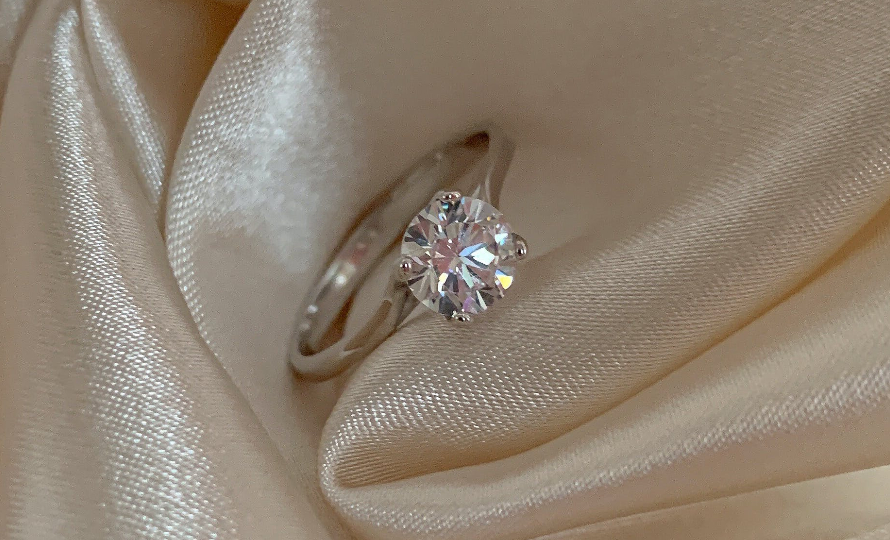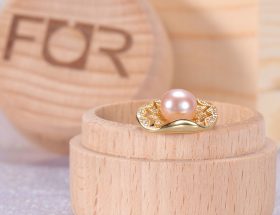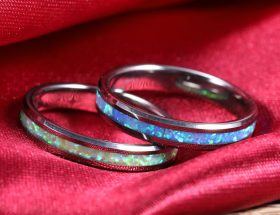Uncover the world of moissanite, a mesmerizing gemstone that has captured the hearts of many with its ethereal brilliance and sustainable properties. Often referred to as the “gem from the star,” it stands out in the world of gemstones for its unique blend of beauty, tenacity and sustainability. As it grows in popularity, gaining momentum in the jewelry world for its ethereal glow and sustainable properties, it’s worth delving into its origins and understanding why it’s become the go-to choice for many.
What is moissanite?
Moissanite is a gemstone that reflects the brilliance of diamonds while possessing its own unique qualities, making it increasingly popular among those looking for sustainable and affordable jewelry options. Born from the stars and first discovered in 1893 by scientist Henri Moissan at a meteor crater, this gemstone has both extraterrestrial origins and terrestrial appeal.
History and Discovery
Henri Moissan initially mistook these sparkling fragments for diamonds. However, upon closer inspection, he realized they were composed of silicon carbide. This marked the birth of “Moissanite”, named after him – a gem from an alien planet.

Physical and chemical properties
Unlike carbon-based diamonds, moissanite is a silicon carbide gemstone. It has a higher refractive index than diamond, and its fire and brilliance often exceed that of its carbon counterpart. It is essentially different from diamond (element C). The Mohs hardness of moissanite is 9.25, which is slightly lower than the Mohs hardness of diamond (the Mohs hardness of diamond is 10, which is the highest level). However, the dispersion value of moissanite is higher than that of diamond, so compared with diamond, Moissanite has better fire than diamonds. As the saying goes, moissanite looks more sparkly than diamonds.
Comparison: Moissanite vs. Diamond
visual differences
At first glance, moissanite can easily be mistaken for a diamond due to its striking luster. However, its high fire can sometimes give it away, especially when it displays colorful flashes under certain lights.
Durability and hardness
Moissanite is second only to diamond on the Mohs scale of hardness, making it very durable and suitable for daily wear.
price point
One of the most attractive features of moissanite is its affordability. Its price is typically a fraction of the price of diamonds, making it a top choice for those on a budget.

Learn about the brilliance of moissanite
refractive index
Moissanite has a refractive index between 2.65 and 2.69, which is higher than diamond. This means it can bend light more efficiently, thereby enhancing brightness.
The fire dispersed
Another fascinating property of moissanite is its ability to break up light into the colors of the rainbow, called fire dispersion. This property often transcends diamonds, giving moissanite its iridescent brilliance.
Choose Moissanite for Jewelry
The emergence of any new things will be accompanied by a certain degree of resistance and resistance, because new things are bound to affect the vested interests of the original things. Similarly, when many diamantaires or jewelers come into contact with moissanite (especially synthetic), because the physical properties of moissanite are very close to diamonds, and some physical properties are even higher than diamonds (such as dispersion value), they should not Mulberry was once considered an excellent substitute for diamonds.
care and maintenance
Like all precious gemstones, moissanite requires care. However, its durability ensures that it can withstand daily wear and tear well and requires minimal maintenance. See How to care for a moissanite ring?
Synthetic vs. Natural Moissanite: Understanding the Origins
Although natural moissanite is very rare and mainly exists in meteorites, the moissanite currently circulating on the market (for jewelry & industrial purposes) is all synthetic (yes, all of it, 100%, without any artificiality at all). ). Is there any natural moissanite? Yes, but very few. The naturally formed ones are basically provided as ore specimens, because the formation of natural moissanite requires a great coincidence, and the probability of natural formation is very low (meteor impact) The carbon-rich layer of the formation forms SI-C bonds due to high temperature and high pressure), and the color of naturally formed moissanite is basically not very pleasing. The colorless, transparent, and blinding stones on the market have all undergone synthetic quality control, so synthetic moissanite is more popular.

The manufacturing process of moissanite
Lab creation
Using advanced technology, moissanite is grown in a controlled environment to ensure high quality and minimal imperfections, and its fire, refraction, clarity, and more can be adjusted to make it sparkle beyond measure.
Quality control and grading
Each moissanite gemstone undergoes a rigorous grading process after creation, similar to the grade of diamonds, ensuring that it meets established standards before reaching the consumer.
Environmental Impact: Moissanite and Traditional Gemstones
Moissanite stands out not only for its brilliance but also for its minimal impact on the environment. The lab-developed process uses fewer resources and causes less ecological damage than traditional mining.
Invest in moissanite jewelry
resale value
While the resale value of moissanite may not rival that of diamonds, its growing popularity has ensured that it holds a respectable place in the resale market. Some rare ones, with special colors and sparkles, appear frequently on the resale market.
Future market forecast
As the world moves towards sustainable choices, the demand for moissanite is expected to rise, making it a gemstone to watch. Why is this predicted? Because diamond prices have plummeted this year and have been impacted by artificial diamonds. In the future, artificial diamonds, moissanite Mulberry and cubic zirconia may occupy most of the diamond market.
Consumer Comments: The Charm of Moissanite
Because the diamond ring has a large value, there are certain risks and inconveniences in daily wear, so I buy a moissanite of equal carat as a substitute for daily wear (anyway, compared with diamonds, moissanite is much cheaper). Even if it is lost or damaged, it won’t be too distressing. The second type of customers generally know that most moissanite is synthetic, but they think it is very sparkling when worn on their hands, and they can afford to buy moissanite as jewelry. It is not bad to buy one and wear it for fun.
Summarize
High-quality moissanite, like diamonds, will never change color or fade. In appearance, it is difficult to tell which is moissanite and which is diamond with the naked eye. The fire of moissanite is obviously better than that of diamond. The biggest difference between moissanite and diamonds is not only the fire color, but also the price. The price of such a perfect moissanite is only one-tenth of that of diamonds. With parameters that are not much different from diamonds, moissanite can be bought cheaply. It is used by young people as gifts, worn by themselves, or as jewelry for wedding rings. The moissanite currently on the market is all artificially synthesized. Since moissanite is artificially synthesized, it means that the more stringent laboratory conditions, the more advanced the process and the more complete the technology, the higher the quality of the moissanite produced. . As long as you know a little bit about moissanite, which is currently recognized as the best quality, you will find that no matter what price range, moissanite will have a “GIA” label to some extent. How much does one carat of moissanite cost? Although moissanite is also a diamond, and even better than diamond in some aspects, moissanite is synthetic after all, and its price is certainly no higher than that of naturally produced diamonds, so the price of moissanite is only one-tenth of that of diamonds. There is a huge difference between the two. This is the difference in rarity.

FAQs
Why is moissanite becoming increasingly popular?
- Moissanite is ethically sourced
- Economical and affordable
- The physical properties are no different from diamonds
- Unparalleled luster
Does moissanite look similar to diamond?
To the untrained eye, yes. However, moissanite has a distinct fire and that iridescent glow due to its higher refractive index.
How is moissanite created in a laboratory?
Using advanced technology, silicon and carbon are combined at high temperatures to create silicon carbide crystals, which are then cut into gemstones.
Is moissanite environmentally friendly?
Yes, mainly because most moissanite is lab-grown, avoiding the environmental impact of traditional mining.
What is the difference between synthetic moissanite and natural moissanite?
Natural moissanite is extremely rare and was originally found in meteorite craters. Synthetic moissanite, on the other hand, is made in a laboratory but has the same physical properties.
How should I care for my moissanite jewelry?
Regular cleaning with mild soap and water and occasional professional cleaning can keep your moissanite jewelry looking its best.










